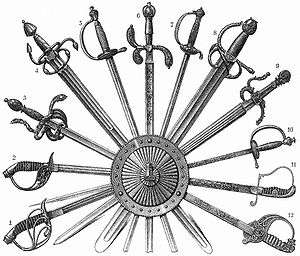Harpe
The harpē (ἅρπη) was a type of sword or sickle; a sword with a sickle protrusion along one edge near the tip of the blade. The harpe is mentioned in Greek and Roman sources, and almost always in mythological contexts.
| Look up harpe in Wiktionary, the free dictionary. |

The harpe sword is most notably identified as the weapon used by Cronus to castrate and depose his father, Uranus. Alternately, that weapon is identified as a more traditional sickle or scythe. The harpe, scythe or sickle was either a flint or adamantine (diamond) blade, and was provided to Cronus by his mother, Gaia. According to an ancient myth recorded in Hesiod's Theogony, Uranus had cast his and Gaia's children, the Cyclopes and Hecatonchires, down into Tartarus. The enraged Gaia plotted Uranus' downfall. She beseeched each of her sons to rise up against Uranus but was refused by all but the youngest, Cronus. So, Gaia provided him with the weapon, and when Uranus next came to lay with Gaia, Cronus leapt up into action and castrated his father, overthrowing him and driving him away forever. Thus the blade (whether harpe, sickle or scythe) became a symbol of Cronus's power.
Perseus, a grandson of Cronus, is also regularly depicted in statues and sculpture armed with a harpe sword in his quest to slay the Gorgon, Medusa, and recover her head to use against Ceto. Perseus was provided with such a sword by his father, Zeus (Cronus' youngest son and later overthrower).
In Greek and Roman art it is variously depicted, but it seems that originally it was a khopesh-like sickle-sword. Later depictions often show it as a combination of a sword and sickle, and this odd interpretation is explicitly described in the 2nd century Leucippe and Clitophon.[1]
See also
Notes
- Achilles Tatius, Leucippe and Clitophon 3.7.8—9: neither shall they die in the right hand, neither shall they die, nor shall the sword be broken. If a man falls under my face, and if one half of the iron sword is in danger of dying, it is not.
